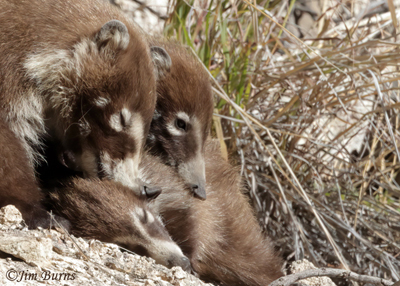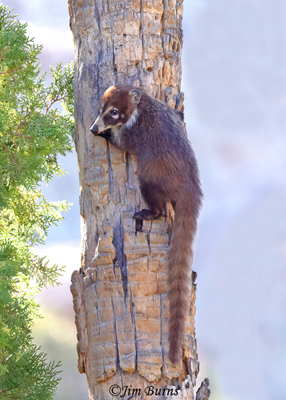
Nowadays, not so much. Not in this decade, perhaps not for the last decade. Some blame new management for clearing out much of the underbrush while others point to the relatively new policy of allowing leashed dogs on the trails. Forty years of birding in Arizona, observing avian behaviors and trends, lead me to think there are simply far fewer birds now, anywhere and everywhere, and you shouldn’t need to be a scientist to understand why.
Nonetheless, this is not a rant about global warming, but a suggestion that there is more than birds for birders to see and celebrate if they continue to visit the beautiful natural areas, such as BTA, that they have always frequented and loved. A case in point is the spectacular presence of non-avian wildlife at BTA this past winter when a band of White-nosed Coatimundi “invaded” BTA and delighted wildlife lovers for nearly a month as they went about their business in the canyon sampling its many fruits and berries.
Coatis (I’m using the plural of the shortened species name which may not be biologically or grammatically correct) are periodically seen at BTA, but typically do not linger there more than a few days. Male Coatis, like hummingbirds and some of our own species, do not help with raising the young, but disperse and live solitary lives as soon as they have taken care of business with the females, so if you see a band of Coatis it is a group of adult females and their young of the previous spring. The band at BTA this past winter was guesstimated to number in the twenties.
Coati kittens are the cutest things on the planet, and watching a band of mothers, each with multiple kits, is an uncommon, fascinating, and memorable experience. Coatis are a smaller, tropical relative of raccoons, and they are in nearly constant motion, always with their flexible noses to the ground for scent, very vocal (growling, huffing, chattering, squealing), and quite adept at climbing the tallest trees and the sheerest rock inclines, amazing and endearing compared to seeing them penned in a zoo.
Last month I spent three different mornings photographing the Coatis at BTA, completely enthralled by the variety of behaviors I observed. As long as visitors were quiet and kept a respectable distance the band seemed oblivious to human presence. Originally discovered in the canyon devouring the large, oblong, purple berries in the Myrtle bushes, they soon crossed Queen Creek to climb high into the Edible Date Palms to eat the fruit ripening at the very top.
Certainly the most notable evolutionary Coati trait is the long, ringed tail, fully the length of their bodies. It is not prehensile but is thought to be a means of contact and communication when the band forages on the ground in tall grasses when it is held erect and high enough for the band can keep track of one another’s movements. When the animals scramble up cliff faces or maneuver among in palm fronds forty feet above the ground, the tail is continuously moving for counterbalance, much like the long poles seen in high wire acts.
When a band moves on from one food source to the next, whether on the ground or descending from a tree, presumably at some signal from the lead female, they do so single file, rapidly, and exactly in the footsteps of the one before them. And unlike Black Bears who descend trees by backing down, Coatis do so head first, defying gravity and vertigo. Yes, those noses are as good as those of bears, those long claws make them athletically adept, and the evolutionary traits that engender their lifestyle are awesome and endearing.
The advantage we birders have over the sedentary members of our own race wringing their hands over climate change is the time we spend in the field. Embrace that time and cherish the amazing diversity in nature’s tapestry. Avian numbers may be down but there’s still a lot going on out there. It’s not just about birds and your lists, and the more you observe and understand the interconnectedness of it all, the better suited you’ll be to help solve the problem.